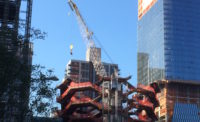
Ronald W. Wackrow
In 2010, when Ronald W. Wackrow was about four months shy of completing the rescue of the troubled 6.5-million-sq-ft Cosmopolitan in Las Vegas, his boss, Related Cos. Chairman Stephen M. Ross, suggested his next assignment: Relocate to the East Coast to steer design and construction of the developer’s 17.5- million-sq-ft Hudson Yards—a 26-acre mini-city primarily sited over the Long Island Railroad yard on the far West Side of Midtown Manhattan.
Wackrow soon packed his bags. “After bringing in the Cosmopolitan on schedule and significantly under budget, I knew I couldn’t go back and work on a single building,” says Wackrow, Related’s executive vice president. “I needed something to get my adrenaline going, and I thought Hudson Yards would be easy, compared to the Cosmopolitan,” which had “highly flawed” plans when Related got involved early in construction, he adds.
The $20-billion Hudson Yards development has gotten Wackrow’s adrenaline going. But in no way has it been easier than the Cosmopolitan turnaround, he says.
![]() In his initial assessment of Hudson Yards, Wackrow neglected to take into account the many restrictions, agency approvals and scrutiny that are part of an air-rights project over an active rail yard. There are rolling trains underfoot. Caissons have to be needled between tracks. Work hours are restricted. Existing tunnels and buried utilities have to be avoided.
In his initial assessment of Hudson Yards, Wackrow neglected to take into account the many restrictions, agency approvals and scrutiny that are part of an air-rights project over an active rail yard. There are rolling trains underfoot. Caissons have to be needled between tracks. Work hours are restricted. Existing tunnels and buried utilities have to be avoided.
There was so much deadline pressure that, to keep everyone on their toes, Wackrow has digital “countdown” clocks—one for each subproject—installed in the conference rooms of the site office, overlooking the project.
For Wackrow, the worst moment of many was when construction was about to begin and Amtrak officials announced they needed to put a tunnel under the development. “This could have derailed the Hudson Yards project by years,” he says.
To avoid that, Wackrow suggested that Related build the tunnel for Amtrak. That solution worked but required an enormous amount of trust, collaboration and cooperation, he says.
The next-biggest challenge on Wackrow’s list had to do with steel procurement, which Related is doing directly. “When we first went to market for [the 1,234-ft-tall] 30 Hudson Yards and the 1-million-sq-ft retail section, the initial prices we received were staggering,” says Wackrow. “That could have precluded our ability to develop the project.”
Wackrow’s work-around: Buy the steel, at better prices, from Mexico, Canada and Italy. The project went ahead, though Wackrow reports that steel deliveries, especially from Mexico, are not as reliable as he would have liked.
Wackrow calls Hudson Yards a total life commitment. For phase one, “we’re tracking on budget and on schedule” for phased completion, ending in 2019, he says.
As a young man, Wackrow, educated as a mechanical engineer, completed a Sheraton Hotels management training program. But he decided he didn’t have the personality to be a hotel manager. He stumbled around for a bit and, in the 1970s, got a job leading construction of motor inns for the developer. Five years later, he got a job with Sheraton, directing design and construction of hotels in Europe, Africa and the Middle East.
Retired architect Hank Brennan first met Wackrow 50 years ago on a Sheraton hotel project in Iran. “Ron has great common sense, he works well with designers, contractors and owners, and he never has an ego,” says Brennan.
Eli B. Gottlieb, a senior principal with Hudson Yards structural engineer Thornton Tomasetti, agrees, saying, “Working with Ron has been a fantastic experience. He charges all of us to really understand the project and come up with creative solutions.”






Post a comment to this article
Report Abusive Comment